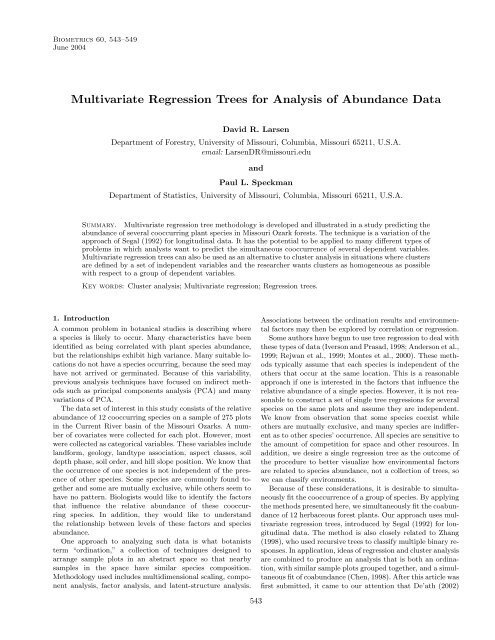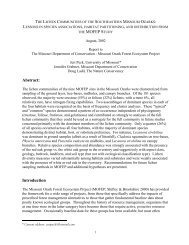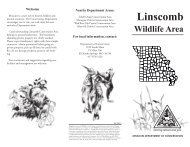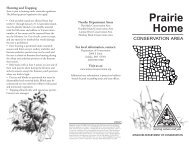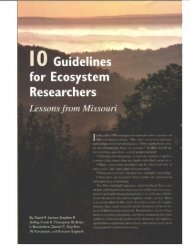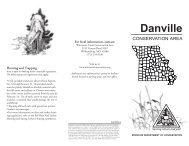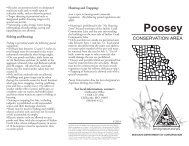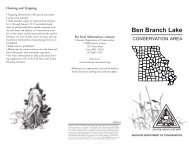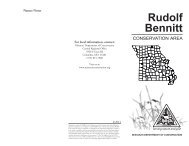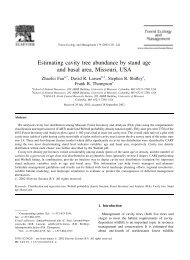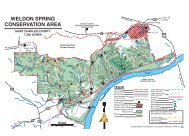Multivariate Regression Trees for Analysis of Abundance Data
Multivariate Regression Trees for Analysis of Abundance Data
Multivariate Regression Trees for Analysis of Abundance Data
You also want an ePaper? Increase the reach of your titles
YUMPU automatically turns print PDFs into web optimized ePapers that Google loves.
Biometrics 60, 543–549<br />
June 2004<br />
<strong>Multivariate</strong> <strong>Regression</strong> <strong>Trees</strong> <strong>for</strong> <strong>Analysis</strong> <strong>of</strong> <strong>Abundance</strong> <strong>Data</strong><br />
David R. Larsen<br />
Department <strong>of</strong> Forestry, University <strong>of</strong> Missouri, Columbia, Missouri 65211, U.S.A.<br />
email: LarsenDR@missouri.edu<br />
and<br />
Paul L. Speckman<br />
Department <strong>of</strong> Statistics, University <strong>of</strong> Missouri, Columbia, Missouri 65211, U.S.A.<br />
Summary. <strong>Multivariate</strong> regression tree methodology is developed and illustrated in a study predicting the<br />
abundance <strong>of</strong> several cooccurring plant species in Missouri Ozark <strong>for</strong>ests. The technique is a variation <strong>of</strong> the<br />
approach <strong>of</strong> Segal (1992) <strong>for</strong> longitudinal data. It has the potential to be applied to many different types <strong>of</strong><br />
problems in which analysts want to predict the simultaneous cooccurrence <strong>of</strong> several dependent variables.<br />
<strong>Multivariate</strong> regression trees can also be used as an alternative to cluster analysis in situations where clusters<br />
are defined by a set <strong>of</strong> independent variables and the researcher wants clusters as homogeneous as possible<br />
with respect to a group <strong>of</strong> dependent variables.<br />
Key words: Cluster analysis; <strong>Multivariate</strong> regression; <strong>Regression</strong> trees.<br />
1. Introduction<br />
A common problem in botanical studies is describing where<br />
a species is likely to occur. Many characteristics have been<br />
identified as being correlated with plant species abundance,<br />
but the relationships exhibit high variance. Many suitable locations<br />
do not have a species occurring, because the seed may<br />
have not arrived or germinated. Because <strong>of</strong> this variability,<br />
previous analysis techniques have focused on indirect methods<br />
such as principal components analysis (PCA) and many<br />
variations <strong>of</strong> PCA.<br />
The data set <strong>of</strong> interest in this study consists <strong>of</strong> the relative<br />
abundance <strong>of</strong> 12 cooccurring species on a sample <strong>of</strong> 275 plots<br />
in the Current River basin <strong>of</strong> the Missouri Ozarks. A number<br />
<strong>of</strong> covariates were collected <strong>for</strong> each plot. However, most<br />
were collected as categorical variables. These variables include<br />
land<strong>for</strong>m, geology, landtype association, aspect classes, soil<br />
depth phase, soil order, and hill slope position. We know that<br />
the occurrence <strong>of</strong> one species is not independent <strong>of</strong> the presence<br />
<strong>of</strong> other species. Some species are commonly found together<br />
and some are mutually exclusive, while others seem to<br />
have no pattern. Biologists would like to identify the factors<br />
that influence the relative abundance <strong>of</strong> these cooccurring<br />
species. In addition, they would like to understand<br />
the relationship between levels <strong>of</strong> these factors and species<br />
abundance.<br />
One approach to analyzing such data is what botanists<br />
term “ordination,” a collection <strong>of</strong> techniques designed to<br />
arrange sample plots in an abstract space so that nearby<br />
samples in the space have similar species composition.<br />
Methodology used includes multidimensional scaling, component<br />
analysis, factor analysis, and latent-structure analysis.<br />
543<br />
Associations between the ordination results and environmental<br />
factors may then be explored by correlation or regression.<br />
Some authors have begun to use tree regression to deal with<br />
these types <strong>of</strong> data (Iverson and Prasad, 1998; Anderson et al.,<br />
1999; Rejwan et al., 1999; Montes et al., 2000). These methods<br />
typically assume that each species is independent <strong>of</strong> the<br />
others that occur at the same location. This is a reasonable<br />
approach if one is interested in the factors that influence the<br />
relative abundance <strong>of</strong> a single species. However, it is not reasonable<br />
to construct a set <strong>of</strong> single tree regressions <strong>for</strong> several<br />
species on the same plots and assume they are independent.<br />
We know from observation that some species coexist while<br />
others are mutually exclusive, and many species are indifferent<br />
as to other species’ occurrence. All species are sensitive to<br />
the amount <strong>of</strong> competition <strong>for</strong> space and other resources. In<br />
addition, we desire a single regression tree as the outcome <strong>of</strong><br />
the procedure to better visualize how environmental factors<br />
are related to species abundance, not a collection <strong>of</strong> trees, so<br />
we can classify environments.<br />
Because <strong>of</strong> these considerations, it is desirable to simultaneously<br />
fit the cooccurrence <strong>of</strong> a group <strong>of</strong> species. By applying<br />
the methods presented here, we simultaneously fit the coabundance<br />
<strong>of</strong> 12 herbaceous <strong>for</strong>est plants. Our approach uses multivariate<br />
regression trees, introduced by Segal (1992) <strong>for</strong> longitudinal<br />
data. The method is also closely related to Zhang<br />
(1998), who used recursive trees to classify multiple binary responses.<br />
In application, ideas <strong>of</strong> regression and cluster analysis<br />
are combined to produce an analysis that is both an ordination,<br />
with similar sample plots grouped together, and a simultaneous<br />
fit <strong>of</strong> coabundance (Chen, 1998). After this article was<br />
first submitted, it came to our attention that De’ath (2002)
544 Biometrics, June 2004<br />
simultaneously developed the same approach <strong>for</strong> marine<br />
species in Australia.<br />
In this article, we wish to show the similarities and differences<br />
with single regression trees and the procedures commonly<br />
used in fitting those trees. We restrict our partitioning<br />
metric to deviance as it is the most common partitioning<br />
metric in single tree regression. Moreover, the algorithm <strong>for</strong><br />
multivariate regression trees using deviance is efficient enough<br />
to use cross-validation in selecting tree size.<br />
1.1 <strong>Data</strong> Description<br />
The data set is from a study designed to develop an ecological<br />
site classification system <strong>for</strong> the Missouri Ozarks. This<br />
project is part <strong>of</strong> an ef<strong>for</strong>t <strong>of</strong> the Missouri Resources Assessment<br />
Partnership (MoRAP), and the data were collected on<br />
275 plots in the summer <strong>of</strong> 1997. Plots were located in Shannon,<br />
Carter, and Oregon counties <strong>of</strong> the southeastern Missouri<br />
Ozarks. The aim <strong>of</strong> the survey was to identify relationships<br />
between the vegetation (species presence and abundance) and<br />
environmental variables (e.g., geology, soil type, and land<strong>for</strong>m).<br />
The independent variables are categorical; Table 1 gives<br />
the number <strong>of</strong> observations by category. The variables are defined<br />
as follows. Landtype association is a layer in a national<br />
hierarchical classification system based on local climate, to-<br />
Table 1<br />
Independent categorical variables with the number<br />
in each category<br />
Variable Category N<br />
Landtype association Current River Breaks 118<br />
Current River Hills 76<br />
Jack Fork, Eminence Breaks 81<br />
Geology Roubidoux 86<br />
Upper Gasconade 107<br />
Lower Gasconade 55<br />
Gunter 6<br />
Eminence 15<br />
Van Buren 6<br />
Land<strong>for</strong>m Summit 16<br />
Shoulder ridge 24<br />
Shoulder 16<br />
Backslope 195<br />
Bench 24<br />
Aspect class Exposed 97<br />
Neutral east 54<br />
Neutral west 45<br />
Protected 79<br />
Phase Deep 226<br />
Variable depth 49<br />
Soil order Alfisol 104<br />
Mollisol 9<br />
None 72<br />
Ultisol 90<br />
Position Upper 90<br />
Upper-middle 28<br />
Middle 51<br />
Lower-middle 28<br />
Lower 61<br />
None 18<br />
Table 2<br />
Dependent variables with the number <strong>of</strong> samples out <strong>of</strong> 275 in<br />
which the species occurred. All other statistics are <strong>for</strong> the<br />
samples in which the species occurred.<br />
Variable N a ¯x Minimum Maximum<br />
Aster patens 118 0.3019 0.01 3.0<br />
Carex digitalis 100 0.4133 0.01 3.0<br />
Desmodium glutinosum 101 3.361 0.01 10.0<br />
Desmodium roundifolium 117 0.2244 0.01 3.0<br />
Euphorbia corollata 122 0.1948 0.01 0.5<br />
Lespedeza intermedia 130 0.2098 0.01 0.5<br />
Monarda russeliana 125 0.4110 0.01 3.0<br />
Panicum commutatum 133 0.2495 0.01 0.5<br />
Phryma leptostachya 106 0.3160 0.01 3.0<br />
Smilax bona-nox 101 1.0650 0.01 20.0<br />
Smilax racemosa 125 0.3244 0.01 3.0<br />
Vaccinium vacillans 195 3.3610 0.01 20.0<br />
a Number <strong>of</strong> samples with this species present from the 275 samples.<br />
All other statistics are <strong>for</strong> only the samples with the species present.<br />
The data <strong>for</strong> these variables are numerical but grouped into six<br />
categories (0, 0.01, 0.5, 3.0, 10.0, 20.0).<br />
pography, geology, soil groups, and broad vegetation patterns<br />
(Keys et al., 1995). Geology describes the surface geological<br />
<strong>for</strong>mations. The materials in the study area are <strong>of</strong> the Ordivician<br />
and Cambrian Periods. Land<strong>for</strong>m is a description <strong>of</strong> the<br />
unit <strong>of</strong> land’s position in a landscape. The values are ordered<br />
from the top <strong>of</strong> a ridge to the valley bottom. Aspect classes<br />
are designed to characterize a location’s exposure to the sun.<br />
“Exposed” designates locations with aspect with 160–250 ◦ azimuth,<br />
“Neutral east” denotes aspects with 71–159 ◦ azimuth,<br />
“Neutral west” denotes aspects with 251–339 ◦ azimuth, and<br />
“Protected” denotes aspects with 340–70 ◦ azimuth. Phase describes<br />
the character <strong>of</strong> the soil, either deep or variable depth<br />
to bedrock. Soil order is the soil taxonomic order. Position is<br />
the relative hill slope position.<br />
Table 2 describes the presence and abundance <strong>of</strong> the dependent<br />
variables. The dependent variables are numerical but<br />
were grouped into six categories (0, 0.01, 0.5, 3.0, 10.0, 20.0).<br />
While this convention may seem unusual to a biometrician, it<br />
is typical <strong>of</strong> the type <strong>of</strong> data commonly collected by botanists.<br />
Botanists are quite confident in their ability to discriminate<br />
categorical differences, but uncom<strong>for</strong>table in attempting to<br />
estimate continuous variables even on a percentage scale. Because<br />
<strong>of</strong> this propensity to collect categorical data, analysis<br />
becomes a challenge. After exploring many options, we concluded<br />
that an extension <strong>of</strong> tree regression to the multivariate<br />
setting would provide an appropriate method to analyze data<br />
<strong>of</strong> this type.<br />
2. <strong>Multivariate</strong> <strong>Regression</strong> <strong>Trees</strong><br />
We assume that the reader is familiar with ordinary regression<br />
tree methodology, and give a brief overview here.<br />
In the classic CART (Classification <strong>Analysis</strong> and <strong>Regression</strong><br />
Tree) program <strong>of</strong> Breiman et al. (1984), a greedy search algorithm<br />
is used to construct a binary tree in the independent<br />
variables. The goal is to produce nodes as homogeneous<br />
as possible with respect to the dependent variable. Consider<br />
the multiple regression problem y i = f(x i1 , ..., x ip ) + ε i ,<br />
i =1,..., n, where f is unknown and not easily parameterized,
<strong>Multivariate</strong> <strong>Regression</strong> <strong>Trees</strong> <strong>for</strong> <strong>Analysis</strong> <strong>of</strong> <strong>Abundance</strong> <strong>Data</strong> 545<br />
x ij are known independent variables, and ε i are random error<br />
terms with zero means. A node N is a subset <strong>of</strong> the indices<br />
{1, ..., n}. The deviance <strong>of</strong> a node N is defined as<br />
∑<br />
D(N) = {y i − ȳ(N)} 2 , (1)<br />
i∈N<br />
where ȳ(N) is the mean over the observations in node N. The<br />
algorithm is recursive. The root node consists <strong>of</strong> all observations.<br />
At each stage, an attempt is made to divide a parent<br />
node N into two child nodes, a “left” node N left and “right”<br />
node N right , so as to minimize D(N left )+D(N right ). Splits <strong>of</strong><br />
the following <strong>for</strong>ms are considered:<br />
1. If x j is a continuous variable, consider all splits <strong>of</strong> the<br />
<strong>for</strong>m N left = {i ∈ N : x ij ≤ t}, N right = {i ∈ N : x ij >t}<br />
<strong>for</strong> constants t.<br />
2. If x j is ordinal, consider all splits as in (1).<br />
3. If x j is categorical with L levels, consider all 2 L subsets.<br />
We need not consider the empty set. Moreover to each<br />
split into left and right subsets, there is an equivalent<br />
split with the subsets reversed. Thus there are actually<br />
2 L−1 − 1 splits to consider.<br />
For each independent variable, all possible splits are considered<br />
according to the appropriate rule, and the deviance <strong>for</strong><br />
the node following the split, D(N left )+D(N right ), is calculated.<br />
The split with the smallest such deviance is saved as a<br />
candidate. The candidate splits are calculated <strong>for</strong> each independent<br />
variable, and the variables whose best split produces<br />
the smallest deviance is the one selected to partition node<br />
N. The algorithm proceeds recursively until no further splitting<br />
is possible according to the predetermined criteria. Typically,<br />
an a priori minimum node size is specified (e.g., 10),<br />
or splitting stops when the deviance <strong>of</strong> a node drops below a<br />
certain level, e.g., 1% <strong>of</strong> the deviance <strong>of</strong> the root node. The<br />
tree <strong>for</strong>med by these rules generally overfits the data, and a<br />
variety <strong>of</strong> strategies have been used to “prune” the tree.<br />
Now consider a multivariate regression setting where more<br />
than one dependent variable is observed, y ij , j = 1,..., r.<br />
The object <strong>of</strong> multivariate regression is to estimate a functional<br />
relationship between the set <strong>of</strong> independent variables<br />
x i1 , ..., x ip and the dependent variables. With a linear regression<br />
model and independent, multivariate normal distributions,<br />
maximum likelihood estimation is well known to be<br />
equivalent to per<strong>for</strong>ming a succession <strong>of</strong> univariate regressions<br />
(Anderson, 1984). However, this strategy is not attractive <strong>for</strong><br />
regression trees, because there is no obvious way to combine<br />
separate, distinct trees into a single one. We seek a single tree<br />
that simultaneously is good <strong>for</strong> estimating the mean response<br />
<strong>of</strong> several dependent variables. Thus it is natural to consider<br />
an extension <strong>of</strong> the definition <strong>of</strong> the partitioning metric, deviance.<br />
Let V N be a known r × r positive definite matrix<br />
defined <strong>for</strong> node N, and let y i =(y i1 , ..., y ir ) t . The vector c<br />
that minimizes<br />
∑<br />
(y i − c) t V −1<br />
N (y i − c) (2)<br />
is clearly<br />
i∈N<br />
ȳ(N) = 1<br />
#N<br />
∑<br />
y i , (3)<br />
i∈N<br />
where #N denotes the number <strong>of</strong> observations in node N. If<br />
V N is proportional to Var (y i ) <strong>for</strong> observations in node N,<br />
∑<br />
D(N) = {y i − ȳ(N)} t V −1<br />
N {y i − ȳ(N)} (4)<br />
i∈N<br />
is a natural definition <strong>of</strong> the deviance <strong>of</strong> the node. With definition<br />
(4) <strong>for</strong> deviance, the recursive algorithm proceeds as in<br />
the univariate case with one modification. When splitting a<br />
node by a categorical variable with L levels (case 3 above) in<br />
univariate regression, it can be shown that one need to consider<br />
only L − 1 subsets instead <strong>of</strong> all 2 L−1 − 1 theoretical<br />
possibilities (Breiman et al., 1984). However, <strong>for</strong> multivariate<br />
regression trees, all splits must be examined, essentially because<br />
Euclidean space is not completely ordered <strong>for</strong> dimension<br />
greater than one.<br />
This approach corresponds to the method <strong>of</strong> Segal (1992).<br />
In his application, the vector y i is a set <strong>of</strong> longitudinal data<br />
on a single individual with covariance matrix proportional to<br />
V N , which also depends on parameters estimated from the<br />
data. Segal noted that taking V to be the sample covariance<br />
matrix <strong>of</strong> the full set <strong>of</strong> dependent variables corresponds to<br />
Hotelling’s T 2 -statistic. Zhang (1998) also investigated this<br />
<strong>for</strong>m <strong>of</strong> deviance (see h 2 in his terminology) <strong>for</strong> binary response<br />
data.<br />
2.1 <strong>Analysis</strong> Methods<br />
A complete tree was fit to the data set using the previously<br />
described methods. We took V to be the sample covariance<br />
matrix <strong>for</strong> the full data set. The greedy algorithm <strong>for</strong> tree<br />
building <strong>of</strong> Breiman et al. (1984) is analogous to <strong>for</strong>ward selection<br />
in regression terminology. To ensure inclusion <strong>of</strong> all<br />
relevant explanatory variables, the tree-building rules are set<br />
to construct a large tree, one which invariably overfits the<br />
data. A procedure analogous to backward selection is then<br />
used to “prune” the tree, i.e., remove some <strong>of</strong> the terminal<br />
nodes.<br />
A goodness-<strong>of</strong>-fit criterion <strong>of</strong> a tree T having terminal nodes<br />
{N k }, say, is defined as<br />
∑<br />
D(T )=<br />
D(N k ). (5)<br />
all terminal nodes N k<br />
If a tree T ′ is a subtree <strong>of</strong> T, clearly D(T ) ≤ D(T ′ ). The pruning<br />
algorithm successively removes pairs <strong>of</strong> terminal nodes<br />
corresponding to the split with the smallest decrease in deviance.<br />
In other words, if T has terminal nodes {N k }, then<br />
each pair, say {N 2j , N 2j+1 }, was the result <strong>of</strong> splitting a higher<br />
node, say N j , with D(N j ) ≥ D(N 2j )+D(N 2j+1 ). All such<br />
pairs <strong>of</strong> terminal nodes are examined, and the pair with the<br />
smallest drop in deviance D(N j ) − D(N 2j ) − D(N 2j+1 )isremoved<br />
to create a new subtree T ′ . (In principle, there could<br />
be more than one pair with the smallest drop in deviance.<br />
In that case, all such pairs would be dropped at the same<br />
time.) The method is analogous to removing the least significant<br />
variable in backward selection. The process is repeated<br />
to create a nested set <strong>of</strong> trees T m ⊂ ··· ⊂ T 0 , where T 0 is the<br />
full tree and T m is the tree consisting <strong>of</strong> only the root node.<br />
To choose among this sequence <strong>of</strong> trees, Breiman et al.<br />
(1984) proposed a cost-complexity measure <strong>for</strong> tree T,<br />
D α (T )=D(T )+α size(T ), (6)
546 Biometrics, June 2004<br />
where α is a suitably chosen cost-complexity parameter. For<br />
fixed α, there is at least one tree that minimizes D α (T). Taking<br />
α =2σ 2 corresponds to AIC. However, in practice AIC<br />
seems to lead to overfitting, and there appears to be no suitable<br />
theory <strong>for</strong> objectively choosing a good α. Conversely,<br />
Breiman et al. (1984) showed that the sequence <strong>of</strong> trees minimizing<br />
D α is nested, so it is possible to consider the nested<br />
sequence as a function <strong>of</strong> α. (In the case <strong>of</strong> ties, more than<br />
one pair <strong>of</strong> terminal nodes may be dropped at the same time.)<br />
The deviance <strong>of</strong> the nested sequence is a decreasing function<br />
<strong>of</strong> α.<br />
Some <strong>for</strong>m <strong>of</strong> cross-validation is commonly used to choose<br />
an appropriate subtree. If a separate validation set is available,<br />
we can use the sequence <strong>of</strong> trees to predict that set and<br />
select the one that minimizes the deviance. More <strong>of</strong>ten, we<br />
split the data set into subsets and use the subsets <strong>for</strong> validation.<br />
Following Breiman et al. (1984) and the implementation<br />
in S, we randomly split the data set into m approximately<br />
equal subsets (typically m = 10). For each subset, a tree is<br />
grown on the remaining data, the optimal nested sequence is<br />
obtained, and the deviance <strong>of</strong> predictions is computed. The<br />
results <strong>of</strong> the m validation runs are averaged to produce a<br />
cross-validation score.<br />
Because the subsets used <strong>for</strong> cross-validation are chosen<br />
at random, the output <strong>of</strong> this cross-validation procedure is<br />
random, and successive runs will produce different plots. In<br />
addition, Breiman et al. (1984) noted that the actual tree chosen<br />
by cross-validation is highly data dependent. Thus crossvalidation<br />
is suggestive, but cannot be used <strong>for</strong> confirmatory<br />
analysis. In our application, we are interested in a tree useful<br />
<strong>for</strong> description purposes, so scientific insight as well as<br />
cross-validation plays an important role in choosing an appropriately<br />
sized tree.<br />
2.2 Results<br />
The full multivariate regression tree T 1 fit to the Missouri<br />
Ozarks data had 44 nodes, some <strong>of</strong> which contained as few<br />
as five observations. A plot <strong>of</strong> the full tree is displayed in<br />
Figure 1. The labels <strong>for</strong> each node show the variable selected<br />
<strong>for</strong> the split; the codes <strong>of</strong> the categories <strong>for</strong> the left node are<br />
also shown. The numbers at each node denote the sizes <strong>of</strong><br />
the nodes, and the length <strong>of</strong> the vertical line segments are<br />
proportional to the drop in deviance corresponding to the<br />
split. The stacked bars under each node indicate the relative<br />
proportion <strong>of</strong> the observations in each node that come from<br />
each species in the dependent variables. Here the multivariate<br />
nature <strong>of</strong> this procedure starts to become apparent.<br />
Next cross-validation was applied to the full tree. After<br />
examining several cross-validation graphs, we chose to use a<br />
tree with three nodes. In our judgment, a three-node tree<br />
vvrel2<br />
dgrel2<br />
astepate2<br />
caredigi2<br />
desmrotu2<br />
euphcoro2<br />
lespinte2<br />
monaruss2<br />
panicomm2<br />
phrylept2<br />
smilbona2<br />
smilrace2<br />
phase:a<br />
aspc:abc<br />
|<br />
geo:a<br />
5<br />
lf:b<br />
5<br />
lta:a lta:b<br />
aspc:a<br />
lf:b<br />
lta:ab<br />
8 6 9 6<br />
11<br />
lf:e<br />
aspc:a<br />
lta:b<br />
5 6 5<br />
geo:d<br />
geo:ce<br />
aspc:ab<br />
lta:b<br />
pos:d<br />
pos:bc<br />
aspc:a<br />
ord:a lf:bd<br />
5 5<br />
lta:a<br />
lf:b pos:acd 9 9 5 pos:bc<br />
pos:abcd<br />
5 5<br />
5<br />
lf:b<br />
5<br />
7 5<br />
6 8<br />
6<br />
8<br />
geo:e<br />
pos:ac pos:ac<br />
geo:c ord:a<br />
6 5<br />
5 7<br />
lta:a<br />
5<br />
8 6<br />
pos:bd<br />
lta:a<br />
pos:abcd<br />
geo:cd<br />
pos:ac<br />
6<br />
lta:b geo:cd 7<br />
6 7<br />
ord:a<br />
7 7<br />
6<br />
5 5<br />
lf:acde<br />
lta:b<br />
5<br />
7 6<br />
Figure 1. Full tree <strong>for</strong> the 12 dependent variables. The labels indicate the variable on which the tree split and the letters<br />
indicate the categories on the left split. The numbers are the number <strong>of</strong> observations at that node.
<strong>Multivariate</strong> <strong>Regression</strong> <strong>Trees</strong> <strong>for</strong> <strong>Analysis</strong> <strong>of</strong> <strong>Abundance</strong> <strong>Data</strong> 547<br />
93.0 46.0 29.0 23.0 22.0 18.0 16.0 15.0 13.0 8.7 7.5 6.5 5.9 4.9 2.8<br />
deviance<br />
3200 3300 3400 3500 3600<br />
1 10 20 30 40<br />
Figure 2. Cross-validation <strong>of</strong> the full tree indicating a reduced tree size <strong>of</strong> 6.<br />
size<br />
was consistently close to the minimum deviance tree. Again,<br />
cross-validation graph calculations are dependent on random<br />
numbers so each graph is different. To correctly evaluate<br />
cross-validation, a number <strong>of</strong> cross-validation graphs must<br />
be viewed to determine the minimum deviance. An example<br />
<strong>of</strong> the cross-validation graph is presented in Figure 2. The<br />
three-node tree is very simple. Because the purpose <strong>of</strong> this<br />
analysis is to describe the factors that indicate differences<br />
among the species, a five-node tree was developed as well.<br />
The pruning procedure was applied to the full tree to reduce<br />
the tree to the best three- and five-node trees. A graphical<br />
representation similar to Figure 1 <strong>of</strong> the pruned three-node<br />
tree is presented in Figure 3 and <strong>of</strong> the pruned five-node tree<br />
is presented in Figure 4. These figures, while fit with the dependent<br />
variables trans<strong>for</strong>med by the square root to account<br />
<strong>for</strong> the fact that the original dependent data is proportional,<br />
are displayed showing counts by terminal node <strong>for</strong> ease <strong>of</strong><br />
interpretation.<br />
2.3 Discussion<br />
<strong>Multivariate</strong> regression trees extend single regression tree<br />
methods. In this article, we have endeavored to illustrate the<br />
analogous components and point out the significant differences.<br />
<strong>Multivariate</strong> regression trees are well suited to situations<br />
where we would like to identify the factors and their<br />
levels that minimize the variation within each species in a<br />
node. The decision to select single or multivariate regression<br />
trees is determined by the response <strong>of</strong> interest, i.e., a single<br />
species response or the combined response <strong>of</strong> a group <strong>of</strong><br />
species. <strong>Multivariate</strong> trees are well suited to determining the<br />
factors that most strongly influence the species group used<br />
<strong>for</strong> the response variables.<br />
We opted to use multivariate regression trees because we<br />
could not assume that the cooccurring species on a set <strong>of</strong> plots<br />
were independent. The response <strong>of</strong> the multivariate regression<br />
tree is the combined differences <strong>of</strong> all species in the species<br />
group. The trees should be expected to be different from single<br />
regression trees developed on each species. They do, however,<br />
illustrate the factors and levels <strong>of</strong> those factors that minimize<br />
the deviance within the species group at a node.<br />
One must keep in mind that the objective <strong>of</strong> this analysis<br />
is to develop a tree that describes the factors that distinguish<br />
differences in species cooccurrence. We felt that one multivariate<br />
tree is much easier to interpret than the 12 species-specific<br />
single trees. The decision between these methodologies is dependent<br />
on the user objectives. If the user is most interested<br />
in the cooccurrence <strong>of</strong> plant species a multivariate tree regression<br />
should be the most appropriate. If it is the factors<br />
effecting a single species occurrence, a single regression tree<br />
should be the most appropriate.<br />
It is generally known that tree regressions are poor at prediction<br />
<strong>of</strong> new observations. Many methods have been developed<br />
to address this problem such as bagging or random<br />
<strong>for</strong>ests (Ghattas, 2000; Breiman et al., 2001). However, since<br />
the results <strong>of</strong> these procedures do not have simple tree structures,<br />
they are not as attractive as the simple tree in our<br />
classification application.<br />
Our multivariate regression trees relate plant abundance to<br />
land<strong>for</strong>m, geology, soil phase, and landtype characteristics <strong>for</strong><br />
select plants in the Current River <strong>of</strong> the Missouri Ozarks. In<br />
Figures 3 and 4, the first split is on aspect class. Aspect class is<br />
a principle factor in the amount <strong>of</strong> solar radiation received at<br />
the plot location and the amount <strong>of</strong> moisture available there.<br />
The second-level split is soil phase. Soil phase has two classes,<br />
deep soils, which make up most <strong>of</strong> the landscape, and variable
548 Biometrics, June 2004<br />
vvrel2<br />
dgrel2<br />
astepate2<br />
caredigi2<br />
desmrotu2<br />
euphcoro2<br />
lespinte2<br />
monaruss2<br />
panicomm2<br />
phrylept2<br />
smilbona2<br />
smilrace2<br />
aspc:abc<br />
|<br />
phase:a<br />
79<br />
154 42<br />
Figure 3. Tree pruned to three nodes. The labels are the variables on which the tree split and the letters indicate the<br />
categories that are on the left split.<br />
vvrel2<br />
dgrel2<br />
astepate2<br />
caredigi2<br />
desmrotu2<br />
euphcoro2<br />
lespinte2<br />
monaruss2<br />
panicomm2<br />
phrylept2<br />
smilbona2<br />
smilrace2<br />
aspc:abc<br />
|<br />
phase:a<br />
geo:a<br />
5 74<br />
154<br />
geo:e<br />
12 30<br />
Figure 4. Tree pruned to five nodes. The labels are the variables on which the tree split and the letters indicate the<br />
categories that are on the left split.
<strong>Multivariate</strong> <strong>Regression</strong> <strong>Trees</strong> <strong>for</strong> <strong>Analysis</strong> <strong>of</strong> <strong>Abundance</strong> <strong>Data</strong> 549<br />
depth soils, which have a much higher plant diversity because<br />
they contain a variety <strong>of</strong> environments. The third-level splits<br />
on geology, which describes the stratographic layers <strong>of</strong> the<br />
surface bedrock.<br />
We explored the issue <strong>of</strong> dependent variable weighting and<br />
found it very hard to develop clear conclusions. We tried trees<br />
developed on the raw data, the square root trans<strong>for</strong>med data,<br />
the square root trans<strong>for</strong>med data weighted by the variance<br />
vector, and the square root trans<strong>for</strong>med data weighted by<br />
the variance/covariance matrix. All these variations created<br />
plausible trees. However, the structures and the order <strong>of</strong> the<br />
variables varied by the method. In the end, we chose to trans<strong>for</strong>m<br />
by the square root and weight by covariance because<br />
<strong>of</strong> our initial concern about the codependence <strong>of</strong> the dependent<br />
variables. Tree regression is a method that given the<br />
dependent variable space makes splits using a single independent<br />
variable that maximizes the deviance between the split<br />
nodes. This is repeated on the end nodes until the end node<br />
reaches a stopping criteria. The nature <strong>of</strong> this method does<br />
not make full use <strong>of</strong> the data set but focuses on key factors. It<br />
is typically applied to data sets that exhibit weak dependent–<br />
independent variable relationships, and the main objective is<br />
to identify factors that most strongly group the data <strong>of</strong> the<br />
dependent variable. Weighting then depends on the aspect<br />
<strong>of</strong> the dependent variable that one wants to emphasis in the<br />
analysis.<br />
The method presented here allows one to use tree regression<br />
methodology on systems <strong>of</strong> correlated dependent variables.<br />
The procedures and diagnostic methods are closely related<br />
to those developed <strong>for</strong> single variable tree regression.<br />
De’ath (2002) suggested several alternative diagnostic tools<br />
that are very familiar to biologists. This methodology has the<br />
potential to be useful <strong>for</strong> many different types <strong>of</strong> problems.<br />
We believe that these methods provide a valuable resource to<br />
researchers with nonstandard classification problems or who<br />
want to predict nonindependent y’s simultaneously.<br />
3. Implementation<br />
We have written a program that runs in S, S-PLUS, or R<br />
on Linux, Solaris, and Windows. The program contains code<br />
to create the regression tree, and modifications <strong>of</strong> S code are<br />
included to estimate an “optimal” tree by cross-validation<br />
and plot the regression trees with the barplots <strong>for</strong> each node.<br />
Because the function produces a standard “tree” object, many<br />
<strong>of</strong> the tree functions work without modification. These are<br />
available from the authors.<br />
Acknowledgements<br />
Jennifer Grabner <strong>for</strong> collecting the data, June-Hung Chen <strong>for</strong><br />
analysis work, and Missouri Resource Assessment Partnership<br />
and Missouri Department <strong>of</strong> Conservation <strong>for</strong> funding<br />
the data collection.<br />
Résumé<br />
Une méthode multivariée par arbres de régression est<br />
développée et illustrée par une étude prédisant l’abondance de<br />
plusieurs espèces sympatriques de plantes des <strong>for</strong>êts d’Ozark<br />
(Missouri, USA). La technique dérive de l’approche de<br />
Segal (1992) pour les données longitudinales. Elle est potentiellement<br />
applicable à de nombreux types de problèmes, en<br />
particulier ceux dans lesquels l’analyste cherche àprédire la<br />
co-occurrence simultanée de plusieurs variables dépendantes.<br />
Les arbres de régression multivariés peuvent aussi être utilisés<br />
comme une alternative à l’analyse hiérarchique par clusters<br />
dans les cas où les groupes sont définis par un ensemble de<br />
variables indépendantes et où le chercheur souhaite obtenir<br />
des groupes les plus homogènes possibles par rapport àun<br />
groupe de variables dépendantes.<br />
References<br />
Anderson, T. W. (1984). An Introduction to <strong>Multivariate</strong> Statistical<br />
<strong>Analysis</strong>, 2nd edition. New York: John Wiley and<br />
Sons.<br />
Anderson, D., Portier, K., Obreza, T., Collins, M., and Pitts,<br />
D. (1999). Tree regression analysis to determine effects <strong>of</strong><br />
soil variability on sugarcane yields. Soil Science Society<br />
<strong>of</strong> America Journal 63, 592–600.<br />
Breiman, L. (2001). Random Forests. Available at http://oz.<br />
berkley.edu/users/breiman.<br />
Breiman, L., Friedman, J. H., Olshen, R. A., and Stone, C. J.<br />
(1984). Classification and Tree <strong>Regression</strong>. Monterey,<br />
Cali<strong>for</strong>nia: Wadsworth and Brooks/Cole.<br />
Chen, J.-H. (1998). <strong>Multivariate</strong> regression trees. Master’s<br />
Thesis, University <strong>of</strong> Missouri-Columbia.<br />
De’ath, G. (2002). <strong>Multivariate</strong> regression trees: A new technique<br />
<strong>for</strong> modeling species–environmental relationships.<br />
Ecology 83, 1105–1117.<br />
Ghattas, B. (2000). Aggregation <strong>of</strong> classification trees. Revue<br />
de Statistique Appliquee—CERESTA 48, 85–98.<br />
Iverson, L. R. and Prasad, A. M. (1998). Predicting abundance<br />
<strong>of</strong> 80 tree species following climate change in the<br />
Eastern United States. Ecological Monographs 68, 465–<br />
485.<br />
Keys, J. E., Jr., Carpenter, C. A., Hooks, S., Koenig, F.,<br />
McNab, W. H., Russell, W., and Smith, M. L. (1995).<br />
Ecological units <strong>of</strong> the eastern United States—first approximation.<br />
USDA Forest Service, Atlanta, Georgia.<br />
Montes, N., Gauquelin, T., Badri, W., Zaoui, E. H., and<br />
Bertaudiere, V. (2000). A non-destructive method <strong>for</strong><br />
estimating above-ground <strong>for</strong>est biomass in threatened<br />
woodlands. Forest Ecology and Management 130, 37–<br />
46.<br />
Rejwan, C., Collins, N. C., Brunner, L. J., Shuter, B. J., and<br />
Ridgeway, M. S. (1999). Tree regression analysis on nesting<br />
habitat <strong>of</strong> smallmouth bass. Ecology 80, 341–348.<br />
Segal, M. R. (1992). Tree-structured methods <strong>for</strong> longitudinal<br />
data. Journal <strong>of</strong> the American Statistical Association 87,<br />
407–418.<br />
Zhang, H. (1998). Classification trees <strong>for</strong> multiple binary responses.<br />
Journal <strong>of</strong> the American Statistical Association<br />
93, 180–193.<br />
Received July 2003. Revised October 2003.<br />
Accepted November 2003.


